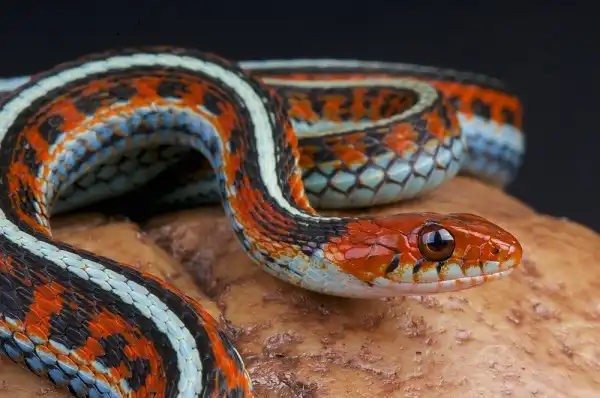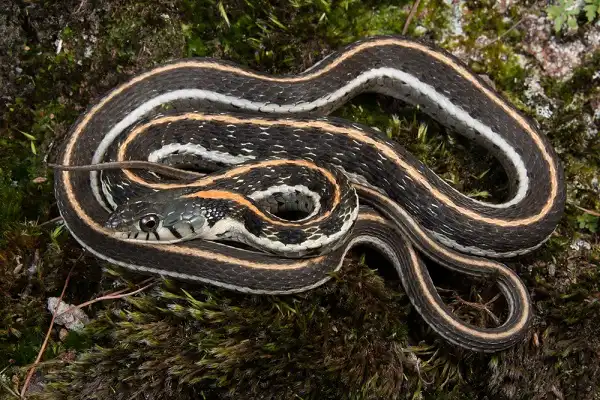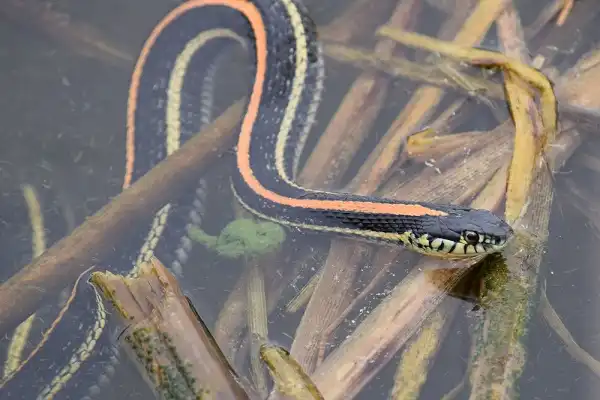Garter snakes are one of the most common snake species in North America. They can be found in a variety of habitats, ranging from forests to urban areas. Garter snakes are relatively small, typically growing between two and three feet in length. Although they are not venomous, garter snakes can be aggressive if threatened. If you come across a garter snake, it is best to leave it alone.

Garter Snake Description
Garter snakes have slender bodies with smooth scales. Their coloring is highly variable, ranging from shades of brown, green, and black to yellow or red stripes running along their back. The most common pattern seen on garter snakes includes three yellow stripes running down the back and one stripe along either side of the body. Garter snakes also have a distinctive “V”-shaped head, which is wider than the neck and typically more brightly colored than the rest of its body.
Garter Snake Habitat
Garter snakes are an adaptable species, with a diverse range of habitats. From forests to fields and from wetlands to urban areas – these slithery critters seem determined not just to survive but thrive in any environment they find themselves in!
Not only do garter snakes favor moist soils that provide protection from predators, but many have even been known to take refuge inside human dwellings such as basements or sheds when necessary. With their penchant for sunning themselves on sidewalk paths and scavenging food like worms, frogs, and insects – it’s no wonder the common garter snake is so well-known (and often loved!) across North America today.
Garter snakes use winter’s frigid temperatures as an opportunity to bravely hibernate. During this time of brumation, in which their metabolic rate drastically decreases, these slimy serpents seek shelter beneath logs and leaf litter for a well-deserved rest from the cold chill of reality!
Garter Snake Diet
Garter snakes are opportunistic omnivores and will feed on a wide variety of prey. They specialize in small vertebrates such as frogs and fish, but they will also eat insects, worms, and other invertebrates. Garter snakes typically hunt by scent rather than by sight, using their tongues to pick up the chemical signals released by potential prey.
In addition to hunting for food, garter snakes can also be scavengers and may eat dead animals or carrion when available. Garter snakes have been known to consume eggs and even small mammals like mice or voles if given the opportunity. As with other snake species, garter snakes must swallow their prey whole; this is why they prefer smaller items that are easier to ingest.
Garter snakes get most of their hydration from the food that they eat; however, in some cases they may also drink standing water if it is present. Additionally, they can absorb moisture from wet grass or moss; this is why it’s important for them to live in areas with plenty of ground cover and moist soils.
Finally, garter snakes can sometimes store extra energy in their bodies by metabolizing body fat which is normally kept at low levels throughout the year. This means that during times of scarcity or harsh winter weather, garter snake populations can survive on stored energy reserves until new sources of food become available.

Garter Snake Size
Garter snakes are a diverse species, with sizes ranging from the tiny Dwarf Garter Snake at just 8-13 inches to the massive Giant Garter Snake which can reach an impressive 5 feet. On average, adult garter snakes measure 20-26 inches and weigh between 1-3 ounces – though females tend to be larger than males. These small creatures thrive in marshlands, ponds, and streams across North America but also inhabit rice fields where their largest kin resides!
Garter Snake Lifespan
Garter snakes typically have a lifespan of between three and five years in the wild, but some species can live up to 10 years or more. In captivity, garter snakes may live even longer due to a more consistent food supply and lack of predators. The average size of a mature garter snake is also related to its lifespan; larger individuals tend to have longer lifespans than smaller ones.
Garter snakes are not generally long-lived animals because they face so many natural dangers such as predators, disease, parasites, and harsh weather conditions. The amount of food available is another major factor influencing their longevity; if there is an abundance of prey items in their environment then they will be able to meet their nutritional needs and survive longer.

Garter Snake Behavior
Garter snakes are diurnal, meaning they are most active during the day and will sleep at night. They spend much of their time basking in the sun to regulate their body temperature, but they also venture out in search of food as soon as it gets dark. These reptiles are mostly solitary creatures, though some species may form small groups during certain times of the year.
Grouping behavior is most commonly seen when garter snakes emerge from hibernation – they gather together for warmth before heading out for the summer months. During warmer months, garter snakes tend to be more active and often can be found swimming or lounging around on land.
Garter Snake Speed
Garter snakes are agile swimmers and can reach speeds of up to three miles per hour when in water. On land, they move much slower – typically reaching a maximum speed of around one mile per hour.
They also use their keen eyesight to track down food sources from a distance. Garter snakes are also capable climbers and can scale walls or trees if necessary. In addition to being fairly fast-moving animals, garter snakes have another trick up their sleeve – they can be quite slippery!
Garter Snake Hunting
Garter snakes are opportunistic feeders and eat a variety of prey items depending on availability. Small invertebrates such as earthworms, slugs, and insects make up the bulk of their diet, but they will also consume amphibians, fish, and other small mammals if given the chance.
These reptiles employ several hunting strategies in order to locate their food sources. They can use their keen sense of smell to sniff out potential meals or use their eyesight to track down moving objects in their environment.

Conclusion
Garter snakes are highly adaptable reptiles that can be found in a variety of habitats across the globe. With proper care, they make excellent pets and have an average lifespan of up to 10 years. Because garter snakes prefer warm temperatures, it is important to provide them with adequate hiding places and plenty of food sources nearby.
Through their swift swimming and climbing abilities – as well as their clever hunting tactics – garter snakes can survive in diverse climates and eat a wide range of prey items. By understanding the basic needs of these fascinating animals, we can ensure they remain healthy and enjoy living in our homes for many years to come!
Frequently Asked Question


